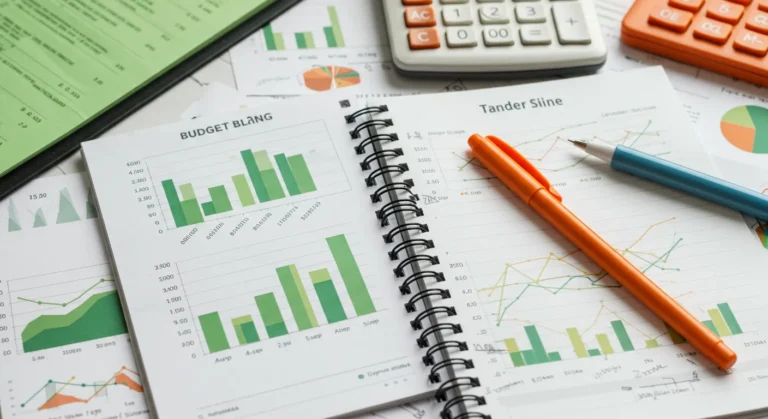What is a realistic monthly budget? In today’s world, understanding how to manage finances can feel overwhelming. The hustle and bustle of everyday life often leaves little room for pondering personal finance. However, creating a realistic monthly budget is not just a luxury; it’s a necessity for financial stability and peace of mind. Whether you’re trying to save for a big purchase or just aiming to keep your expenses in check, having a well-structured budget can lead you to your financial goals.
When we talk about a monthly budget, we’re diving into the nitty-gritty of what it means to balance income and expenses. A good budget shouldn’t just be a list of numbers; it should reflect your lifestyle, priorities, and ambitions. So, let’s unravel this topic together and see how we can tailor a practical budget that works for you without sacrificing your peace of mind or fun.
Imagine being able to track your spending habits and make informed decisions, and picture the relief of knowing exactly where every dollar is going. This article will guide you through the essentials of building a realistic monthly budget that aligns with your life goals. We’ll explore budget categories, provide insights into income allocation, and show how to adjust for unexpected expenses—all while ensuring you still have enough to enjoy life.
So, grab a cup of coffee, and let’s break down the elements of a realistic monthly budget! By the end, you’ll have not just the theoretical knowledge but also practical steps to implement a budget that feels both doable and enriching.
Understanding Income: The Foundation of Your Budget
Before anything else, let’s get a grip on your income. This isn’t just about your salary; it’s the total cash flow you have each month. Think about not only your paycheck but any side gigs, rental income, or investments that might produce revenue. It might seem a bit daunting, so let’s simplify it into actionable steps.
List All Income Sources
First things first, make a list of all your income sources. This gives you a clearer picture of your financial landscape.
- Salary from your primary job.
- Money earned from side hustles (freelancing, tutoring, etc.).
- Dividends from investments.
- Any rental income from properties.
Once you’ve laid out the sources, calculate the total monthly income. Remember, it’s vital to focus on net income—what you actually take home after taxes and deductions—not just gross income.
Essential Budget Categories: Where Does Your Money Go?
With a clear understanding of your income, it’s time to categorize your expenses. Having distinct categories not only simplifies tracking but also helps you see where you can cut back if needed. Generally, expenses can be divided into fixed and variable categories.
Fixed vs. Variable Expenses
Your fixed expenses are the consistent payments that don’t vary much month to month. Here’s a list to consider:
- Rent or mortgage payments.
- Car payments.
- Insurance (health, auto, home).
On the flip side, variable expenses can fluctuate. Things like groceries, entertainment, and clothing might change based on your choices or lifestyle. Knowing this distinction helps in adjusting your budget more intelligently.
Setting Financial Goals: The “Why” Behind Your Budget
No discussion about budgeting can be complete without touching on why you’re budgeting in the first place. Setting clear financial goals will give your budget purpose and make the tedious task of tracking expenses more worthwhile. Are you saving for a dream vacation, a new car, or perhaps even building an emergency fund?
Short-Term vs. Long-Term Goals
Take a moment to distinguish between short-term and long-term goals.
- Short-term goals: These might be things you want to achieve within a year, like paying off credit card debt.
- Long-term goals: These could span several years, such as saving for retirement or a child’s education.
By knowing your objectives, you can allocate funds more effectively. Budgeting becomes less about restriction and more about achieving what you truly desire.
Creating Your Budget: The Steps to Real Financial Control
Alright, now that we have the basics laid out, it’s time for the exciting part—creating your budget! Building a budget can be a creative endeavor; it’s like constructing your personal balance sheet where you control the narrative.
Choose a Budgeting Method
There are various budgeting methods to experiment with, and you can choose one that resonates with you the most. Here are the most popular:
- The 50/30/20 Rule: Allocate 50% of your income to needs, 30% to wants, and 20% to savings.
- Envelope System: Withdraw cash for specific categories and put them into envelopes; once the cash is gone, you’re done spending in that category.
- Zero-Based Budget: Every dollar you earn is allocated to expenses, savings, or debt repayment until you reach zero.
Whichever method you choose, ensure it fits your lifestyle and financial goals. Don’t hesitate to tweak the categories over time as your needs change.
Monitoring and Adjusting Your Budget: The Key to Longevity
The best part of budgeting? It’s not set in stone. Life changes, and so can your budget. Regularly monitoring your expenses and income can help make sure you’re on track to meet your goals. But how often should you check in?
Regular Budget Reviews
Consider setting aside time each month for a financial check-up. During this review, look at:
- Are you staying within your spending limits?
- Did any unexpected expenses arise?
- How do you feel about your progress toward your goals?
This will not only help you stay disciplined but also gives you a chance to celebrate your wins, whether big or small. Remember, budgeting is a dynamic process, not a one-time task.

Useful links
Conclusion
Creating a realistic monthly budget is like crafting a personalized roadmap to your financial goals. It’s not merely about cutting out lattes or forgoing dining out; it’s about understanding where each dollar comes from and where it goes. We’ve explored various income sources, essential expenses, and discretionary spending, discovering that budget creation is as much about your lifestyle choices as it is about numbers.
I hope you’ve realized that budgeting isn’t a punishment; it’s a form of freedom. When you take the time to track your finances, you are empowering yourself to make informed decisions. Consider this process a dynamic tool, adaptable to life’s ups and downs, and not a rigid plan that stifles spontaneity or joy. Embrace the flexibility that comes with adjusting your budget as your life evolves.
As you embark on your budgeting journey, remember that the goal is not perfection but progress. Whether you’re saving for a dream vacation, planning for a major purchase, or simply trying to live within your means, a well-structured budget can help you achieve those aspirations. Let’s take the plunge and make our money work for us, allowing us to focus on what truly matters—living well and enjoying life to the fullest.
Frequently Asked Questions
What are the key components of a realistic monthly budget?
A realistic monthly budget should encompass your total income, fixed expenses, variable expenses, savings, and debt payments. Start by listing all your income sources—salary, side hustles, or passive income—and ensure you know your expected monthly total. Next, identify fixed expenses like rent or mortgage payments, utility bills, and insurance. Following that, outline variable expenses such as groceries and entertainment. Don’t forget to include savings goals and any debt repayments. This comprehensive approach ensures you have a clear picture of your financial landscape.
How can I stick to my monthly budget?
Sticking to a budget can be challenging, but it’s achievable with a few practical strategies. First, regularly review your budget to ensure it reflects your current situation. Use budgeting apps or spreadsheets that allow you to track expenses easily. Setting reminders for bill payments can reduce the risk of late fees. Consider the “50/30/20 rule,” which allocates 50% of income to needs, 30% to wants, and 20% to savings and debt repayment. Lastly, celebrate small victories along the way and adjust your budget as necessary to accommodate unexpected expenses.
How often should I revise my budget?
Revision frequency largely depends on your financial situation. A good rule of thumb is to review your budget monthly, especially after any significant life changes, like a job shift, moving, or a major purchase. This is also important for assessing your financial goals. If you find yourself consistently straying from your budget, it may be time to reassess your spending habits or your income projections. Regular check-ins keep your budget relevant and aligned with your current lifestyle.
What should I do if my expenses exceed my budget?
First, don’t panic! It’s common for expenses to occasionally exceed your budget. Take a step back and analyze where the overspending occurred. Look for categories where you can cut back, like dining out or entertainment. Consider re-evaluating your budget to reflect these changes or identify if there are unexpected expenses that need addressing. If overspending is a recurring theme, it may be time to adjust your budget, making it more realistic to avoid frustration and encourage sustainable financial management.
Is it necessary to have a savings plan in my budget?
Absolutely! Including a savings plan in your budget is crucial for building financial security. It’s not just about having money set aside for emergencies; it’s also about reaching long-term goals like retirement, vacations, or major purchases. Experts recommend saving at least 20% of your income if possible. Start small if you’re not currently saving; even a little adds up over time. Having designated savings can help you avoid debt and provide peace of mind in case of unexpected expenses.
Can I have a budget if my income fluctuates?
Yes, creating a budget when your income is inconsistent can be challenging, but it’s definitely possible. Start by calculating your average income over several months to get a baseline. Then, prioritize your fixed expenses to ensure they’re covered during lean months. Utilizing a zero-based budgeting approach can also work well; allocate every dollar with intention, whether it’s savings or necessary spending. Consider having a buffer of savings to help manage fluctuating income and keep your budget on track.
What’s the biggest mistake people make with their budgets?
One of the most common mistakes is underestimating discretionary spending. Many people forget to account for small purchases that can add up quickly, like coffee runs or impulse buys. Another misstep is failing to adjust the budget after achieving financial goals, which can lead to complacency. It’s also easy to become discouraged if the budget feels too restrictive. The key is to maintain a balance; allow room for fun while ensuring essential expenses and savings needs are met. Regular engagement with your budget helps prevent these pitfalls and fosters a healthier financial mindset.


